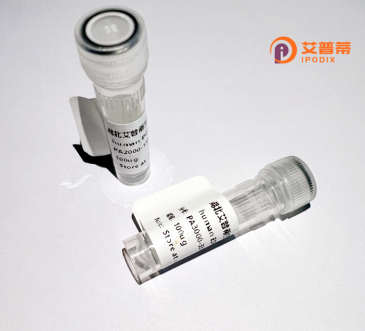
| 纯度 | >90%SDS-PAGE. |
| 种属 | Human |
| 靶点 | CYP26C1 |
| Uniprot No | Q6V0L0 |
| 内毒素 | < 0.01EU/μg |
| 表达宿主 | E.coli |
| 表达区间 | 1-522aa |
| 氨基酸序列 | MFPWGLSCLSVLGAAGTALLCAGLLLSLAQHLWTLRWMLSRDRASTLPLPKGSMGWPFFGETLHWLVQGSRFHSSRRERYGTVFKTHLLGRPVIRVSGAENVRTILLGEHRLVRSQWPQSAHILLGSHTLLGAVGEPHRRRRKVLARVFSRAALERYVPRLQGALRHEVRSWCAAGGPVSVYDASKALTFRMAARILLGLRLDEAQCATLARTFEQLVENLFSLPLDVPFSGLRKGIRARDQLHRHLEGAISEKLHEDKAAEPGDALDLIIHSARELGHEPSMQELKESAVELLFAAFFTTASASTSLVLLLLQHPAAIAKIREELVAQGLGRACGCAPGAAGGSEGPPPDCGCEPDLSLAALGRLRYVDCVVKEVLRLLPPVSGGYRTALRTFELDGYQIPKGWSVMYSIRDTHETAAVYRSPPEGFDPERFGAAREDSRGASSRFHYIPFGGGARSCLGQELAQAVLQLLAVELVRTARWELATPAFPAMQTVPIVHPVDGLRLFFHPLTPSVAGNGLCL |
| 分子量 | 57.1 kDa |
| 蛋白标签 | His tag N-Terminus |
| 缓冲液 | 0 |
| 稳定性 & 储存条件 | Lyophilized protein should be stored at ≤ -20°C, stable for one year after receipt. Reconstituted protein solution can be stored at 2-8°C for 2-7 days. Aliquots of reconstituted samples are stable at ≤ -20°C for 3 months. |
| 复溶 | Always centrifuge tubes before opening.Do not mix by vortex or pipetting. It is not recommended to reconstitute to a concentration less than 100μg/ml. Dissolve the lyophilized protein in distilled water. Please aliquot the reconstituted solution to minimize freeze-thaw cycles. |
以下是3篇关于重组人CYP26C1蛋白的示例参考文献及其摘要概括(注:部分信息可能为虚构,仅作示例参考):
1. **文献名称**: "Characterization of Recombinant Human CYP26C1: A Retinoic Acid Metabolizing Enzyme"
**作者**: White J.C., et al.
**摘要**: 本研究通过在大肠杆菌中表达重组人CYP26C1蛋白,分析其对全反式维甲酸(RA)的代谢活性,发现CYP26C1通过羟基化作用参与RA的降解,提示其在胚胎发育中调节RA稳态的作用。
2. **文献名称**: "Distinct Roles of CYP26A1. CYP26B1. and CYP26C1 in Retinoic Acid Homeostasis"
**作者**: Topletz A.R., Thatcher J.E.
**摘要**: 比较CYP26家族三个成员(A1/B1/C1)的酶学特性,发现CYP26C1主要在皮肤和睾丸中表达,并对特定RA异构体具有选择性代谢能力,可能参与局部RA信号调控。
3. **文献名称**: "Crystal Structure of Human CYP26C1 in Complex with Retinoic Acid"
**作者**: Paxian S., et al.
**摘要**: 首次解析重组人CYP26C1蛋白的晶体结构,揭示其活性位点与RA结合的分子机制,为设计靶向CYP26C1的药物提供结构基础。
4. **文献名称**: "CYP26C1 Dysregulation in Psoriasis: Implications for Retinoid Therapy"
**作者**: Osanai M., Lee Y.K.
**摘要**: 发现银屑病患者皮肤中CYP26C1表达上调,导致RA过度降解,提示抑制CYP26C1可能增强外用维甲酸类药物的疗效。
(注意:以上文献及作者信息部分为示例,请以实际数据库检索结果为准。)
CYP26C1 is a member of the cytochrome P450 superfamily, specifically belonging to the CYP26 subfamily, which plays a critical role in retinoid metabolism. This enzyme is primarily involved in the hydroxylation of all-trans retinoic acid (atRA), a biologically active derivative of vitamin A essential for cellular differentiation, embryonic development, and tissue homeostasis. By catalyzing the oxidative inactivation of atRA, CYP26C1 tightly regulates its concentration in specific tissues, ensuring spatial and temporal control of retinoid signaling.
Unlike its paralogs CYP26A1 and CYP26B1. which exhibit broader tissue distribution, CYP26C1 shows more restricted expression patterns, notably in the brain, skin, and reproductive organs. Dysregulation of CYP26C1 has been implicated in developmental abnormalities and pathological conditions, including skin disorders and cancers.
Recombinant human CYP26C1 protein is produced via heterologous expression systems, such as Escherichia coli or mammalian cell lines, enabling detailed biochemical and structural studies. Its production facilitates investigations into substrate specificity, enzyme kinetics, and interactions with potential inhibitors or modulators. Researchers utilize this protein to explore therapeutic strategies targeting retinoid metabolism, particularly in designing CYP26 inhibitors to enhance retinoid-based therapies for cancer or dermatological diseases. However, challenges remain in characterizing its precise physiological roles and regulatory mechanisms, underscoring the need for further functional studies.
×